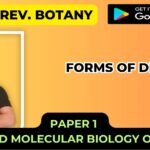![]()
REPLICATION AND PROTEIN SYNTHESIS
Chloroplast DNA replicates by a semi conservative mechanism involving the formation of D Loops

Chloroplast DNA replication is the process by which the genetic material in chloroplasts, the organelles responsible for photosynthesis in plant cells, is duplicated. Chloroplasts contain their own circular DNA molecules, similar to mitochondrial DNA, and they must replicate to ensure that each new chloroplast, formed during cell division or growth, has a complete set of genetic instructions for photosynthesis and other essential functions. Here’s an explanation of chloroplast DNA replication in English:
- Chloroplast DNA: Chloroplasts are organelles found in plant cells and some other eukaryotic organisms. They contain a small, circular DNA molecule, known as chloroplast DNA or cpDNA, in addition to the photosynthetic machinery.
- Replication Initiation: Chloroplast DNA replication starts with the initiation of DNA unwinding. Enzymes responsible for replication unwind the double-stranded circular DNA molecule.
- Primer Formation: Just like in nuclear DNA replication, a short RNA primer is synthesized complementary to one of the DNA strands. This primer provides a starting point for DNA synthesis.
- DNA Synthesis: DNA polymerase, an enzyme responsible for DNA replication, begins synthesizing a new DNA strand complementary to the template strand using the RNA primer as a starting point. This process proceeds in both directions around the circular DNA molecule.
- Bidirectional Replication: Chloroplast DNA replication is bidirectional, meaning it occurs in two directions from the initial starting point. This ensures that the entire circular DNA molecule is copied.
- Complementary Strand Synthesis: As DNA synthesis progresses, the original DNA strands are used as templates to create new complementary strands. This results in the formation of two identical circular DNA molecules.
- Completion: Once replication is complete, there are now two fully duplicated chloroplast DNA molecules within the chloroplast.
Chloroplast DNA replication is essential for the proper functioning of chloroplasts and, consequently, for photosynthesis and other metabolic processes in plant cells. It allows the chloroplasts to inherit genetic information as they divide and multiply during plant growth and development.
It’s worth noting that chloroplast DNA replication is similar in some aspects to bacterial DNA replication because chloroplasts are believed to have originated from ancient photosynthetic bacteria that were engulfed by early eukaryotic cells in a process called endosymbiosis. As a result, chloroplast DNA replication shares some similarities with bacterial DNA replication.
Chloroplast contains 70S ribosomes.
Chloroplast ribosomes resembles with prokaryotes in following features-in use of N-formylmethionine as initiating codon and in basic structures of their RNAs.
Chloroplast synthesize polypeptides whose genes reside in chloroplast DNA.
Chloroplast protein synthesis has been studied the first product of chloroplast protein synthesis to be identified was the large subunit of rubisco, the CO2-fixing enzyme of the calvin cycle that consists of a large catalytic subunit and a smaller regulatory subunit. synthesis of the small rubisco subunits is selectively inhibited in the presence of cycloheximide, whereas formation of the large subunit is blocked by chloromphenicol.
Thus the small subunit in the chloroplast. Verification of this conclusion has come from experiments showing that isolated chloroplasts synthesize the large but not the small rubisco subunit.
Moreover the gene coding for the large rubisco subunit has been identified in chloroplast DNA, thereby providing further support for the idea that this polypeptide is synthesized in chloroplasts. although rubisco is a soluble protein located in the chloroplast stroma, many polypeptides synthesized by chloroplasts have turned out to be thylakoid membrane proteins. Among them are subunits of protein complexes involved in photosynthetic electron transfer (photosystem II, the cytochrome b0f complex and photosystem I) and subunits of the ATP-synthesizing CF0-CF1 complex.
Chloroplasts also synthesize some of the polypeptides found in chloroplast ribosomes and chloroplast RNA polymerase. As in the case of mitochondria, all the polypeptides synthesized by chloroplasts are encoded by chloroplast DNA













